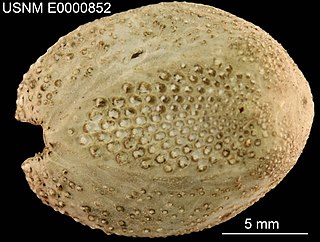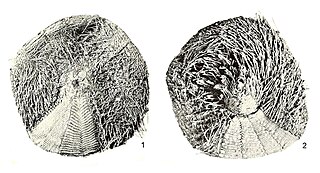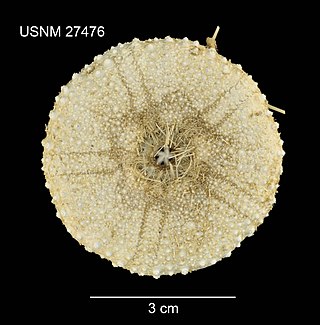
Arachnoides is a genus of sea urchin within the family Clypeasteridae, found in the Indo-Pacific oceans. The base is flat and the upper surface is convex.

Aceste ovata is a species of sea urchin of the family Schizasteridae. Their armour is covered with spines. It came from the genus Aceste and lives in the sea. Aceste ovata was first scientifically described in 1907 by Alexander Emanuel Agassiz & Hubert Lyman Clark.
Amblypneustes grandis is a species of sea urchin of the family Temnopleuridae. Their armour is covered with spines. It is in the genus Amblypneustes and lives in the sea. Amblypneustes grandis was first scientifically described in 1912 by Hubert Lyman Clark.
Ammotrophus arachnoides is a species of sand dollar of the family Arachnoididea. Their external skeleton, known as a test, is covered with spines. It belongs to the genus Ammotrophus and lives in the sea off southern Australia. Ammotrophus arachnoides was first scientifically described in 1938 by Hubert Clark.
Ammotrophus cyclius is a species of sand dollar of the family Clypeasteridae. Their external skeleton, known as a test, is covered with spines. It belongs to the genus Ammotrophus and lives in the seas off southern Australia. Ammotrophus cyclius was first scientifically described in 1928 by Hubert Clark.
Ammotrophus platyterus is a species of sand dollar of the family Clypeasteridae. Their armour is covered with spines. It came from the genus Ammotrophus and lives in the sea. Ammotrophus platyterus was first scientifically described in 1928 by Hubert Clark.
Anametalia regularis is a species of sea urchin of the family Brissidae. Their armour is covered with spines. It is placed in the genus Anametalia and lives in the sea. Anametalia regularis was first scientifically described in 1925 by Hubert Clark.

Apatopygus occidentalis is a species of sea urchin of the family Apatopygidae. Their armour is covered with spines. It is placed in the genus Apatopygus and lives in the sea. Apatopygus occidentalis was first scientifically described in 1928 by Hubert Lyman Clark, American zoologist.
Aporocidaris fragilis is a species of sea urchin of the family Ctenocidaridae. It is well-armoured with spines. It is placed in the genus Aporocidaris and lives in the sea. Aporocidaris fragilis was first scientifically described in 1907 by Alexander Emanuel Agassiz & Hubert Lyman Clark.
Araeosoma eurypatum is a species of sea urchin of the family Echinothuriidae. Its armour is covered with spines. It is placed in the genus Araeosoma and lives in the sea. A. eurypatum was first scientifically described in 1909 by Alexander Agassiz and Hubert Clark.

Araeosoma leptaleum is a species of sea urchin of the family Echinothuriidae. Its armour is covered with spines. It is placed in the genus Araeosoma and lives in the sea. A. leptaleum was first scientifically described in 1909 by Alexander Emanuel Agassiz & Hubert Lyman Clark.
Araeosoma paucispinum is a species of sea urchin of the family Echinothuriidae. Its armour is covered with spines. It is placed in the genus Araeosoma and lives in the sea. A. paucispinum was first scientifically described in 1924 by Hubert Lyman Clark, an American zoologist.

Araeosoma thetidis is a species of sea urchin of the family Echinothuriidae that lives in deep sea off Australia and New Zealand. A. thetidis was first scientifically described in 1909 by Hubert Lyman Clark.
Argopatagus planus is a species of sea urchin of the family Macropneustidae. Their armour is covered with spines. It is placed in the genus Argopatagus and lives in the sea. Argopatagus planus was first scientifically described in 1907 by Alexander Emanuel Agassiz and Hubert Lyman Clark, American scientists.

Asthenosoma intermedium is a species of sea urchin of the family Echinothuriidae. Their armour is covered with spines. It is placed in the genus Asthenosoma and lives in the sea. Asthenosoma intermedium was first scientifically described in 1938 by Hubert Lyman Clark.
Brisaster kerguelenensis is a species of sea urchins of the family Schizasteridae. Their armour is covered with spines. Brisaster kerguelenensis was first scientifically described in 1917 by Hubert Lyman Clark.

Centrostephanus tenuispinus is a species of sea urchin of the family Diadematidae. Their armour is covered with spines. Centrostephanus tenuispinus was first scientifically described in 1914 by Hubert Lyman Clark.

Chaetodiadema pallidum is a species of sea urchins of the Family Diadematidae. Their armour is covered with spines. Chaetodiadema pallidum was first scientifically described in 1907 by Alexander Emanuel Agassiz and Hubert Lyman Clark.
Chaetodiadema tuberculatum is a species of sea urchins of the Family Diadematidae. Their armour is covered with spines. Chaetodiadema tuberculatum was first scientifically described in 1909 by Hubert Lyman Clark.

Chondrocidaris brevispina, the raspberry sea urchin, is a species of sea urchins of the family Cidaridae. Their armour is covered with short, conical spines.










